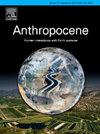Exploring the role of a Mediterranean transhumance drove road as shelter for amphibian breeding
IF 3.3
2区 地球科学
Q2 ENVIRONMENTAL SCIENCES
引用次数: 0
Abstract
Amphibians face global population declines due to environmental degradation and habitat loss, particularly impacting breeding water bodies. Thus, we hypothesise that water bodies associated with traditional pastoralist practices, such as those along drove roads used for transhumance (e.g. ponds and troughs), may play a crucial role in supporting amphibian assemblages. Conducted in one of the main drove roads still in use in Spain (the Conquense Drove Road, hereafter CDR), this study evaluated the conservation condition and contribution of the CDR water bodies to amphibian breeding assemblages at a landscape scale. We also explored the influence of landscape (land use cover) and local (water body characteristics) variables on the occurrence of breeding amphibians within and outside the CDR. Results confirm that the CDR provides a significantly higher proportion of functional water bodies to the landscape compared to its surroundings, providing highly valuable refuges for amphibians against threats caused by land use intensification. This key function of the CDR in the maintenance of amphibian breeding points persists despite the observed lack of continuity of water bodies along its route. Ponds and the most naturalized troughs (the minority of them) were identified as the most suitable habitats, supporting species such as Discoglossus galganoi, Pleurodeles waltl, Epidalea calamita, Hyla molleri, Pelobates cultripes, Pelodytes punctatus, and Pelophylax perezi. Only the latter two were found in troughs. While pond creation and restoration should be prioritized due to their higher suitability for amphibians, we demonstrated that troughs still serve as complementary habitats and refuges if properly managed. We recommend ensuring a minimum hydroperiod, promoting the development of sediment and macrophytes, and implementing access ramps for terrestrial wildlife.
探索地中海迁徙道路作为两栖动物繁殖庇护所的作用
由于环境退化和栖息地丧失,特别是对繁殖水体的影响,两栖动物面临全球数量下降的问题。因此,我们假设,与传统畜牧业有关的水体,如用于畜牧业的公路沿线的水体(如池塘和水槽),可能在支持两栖动物群落方面发挥关键作用。本研究选取西班牙仍在使用的主要公路之一(conconense drive Road,以下简称CDR),在景观尺度上评价了CDR水体对两栖动物繁殖组合的保护状况和贡献。我们还探讨了景观(土地利用覆盖)和局部(水体特征)变量对CDR内外两栖动物繁殖发生的影响。结果表明,与周边环境相比,CDR为景观提供了更高比例的功能水体,为两栖动物抵御土地利用集约化带来的威胁提供了非常宝贵的避难所。尽管观察到沿途水体缺乏连续性,但CDR在维持两栖动物繁殖点方面的关键功能仍然存在。池塘和归化程度最高的沟槽(占少数)是最适宜的生境,支持种有:galgalanoi Discoglossus galgalanoi、Pleurodeles waltl、Epidalea calamita、Hyla molleri、Pelobates cultripes、Pelodytes punctatus和Pelophylax perezi。只有后两种是在水槽里发现的。虽然池塘的创建和恢复应该优先考虑,因为它们更适合两栖动物,但我们证明,如果管理得当,水槽仍然可以作为补充栖息地和避难所。我们建议确保最小水期,促进沉积物和大型植物的发展,并实施陆生野生动物的通道坡道。
本文章由计算机程序翻译,如有差异,请以英文原文为准。
求助全文
约1分钟内获得全文
求助全文
来源期刊

Anthropocene
Earth and Planetary Sciences-Earth and Planetary Sciences (miscellaneous)
CiteScore
6.30
自引率
0.00%
发文量
27
审稿时长
102 days
期刊介绍:
Anthropocene is an interdisciplinary journal that publishes peer-reviewed works addressing the nature, scale, and extent of interactions that people have with Earth processes and systems. The scope of the journal includes the significance of human activities in altering Earth’s landscapes, oceans, the atmosphere, cryosphere, and ecosystems over a range of time and space scales - from global phenomena over geologic eras to single isolated events - including the linkages, couplings, and feedbacks among physical, chemical, and biological components of Earth systems. The journal also addresses how such alterations can have profound effects on, and implications for, human society. As the scale and pace of human interactions with Earth systems have intensified in recent decades, understanding human-induced alterations in the past and present is critical to our ability to anticipate, mitigate, and adapt to changes in the future. The journal aims to provide a venue to focus research findings, discussions, and debates toward advancing predictive understanding of human interactions with Earth systems - one of the grand challenges of our time.
 求助内容:
求助内容: 应助结果提醒方式:
应助结果提醒方式:


